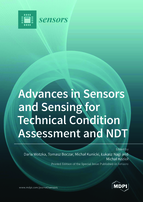Advances in Sensors and Sensing for Technical Condition Assessment and NDT
A special issue of Sensors (ISSN 1424-8220). This special issue belongs to the section "Physical Sensors".
Deadline for manuscript submissions: closed (15 December 2020) | Viewed by 34888
Special Issue Editors
Interests: issues related to electrical engineering; power engineering; renewable energy sources; automatic diagnostic methods of insulation systems of power equipment
Special Issues, Collections and Topics in MDPI journals
Interests: measurements and metrology; technical diagnostics; non-destructive testing
Special Issues, Collections and Topics in MDPI journals
Interests: acoustic emissions; infrasound; signal processing; machine learning
Interests: high-voltage techniques; radiation measurements; non-destructive testing; nanoparticles
Special Issues, Collections and Topics in MDPI journals
Interests: high voltage technique; optical signals metrology and its analysis using machine learning methods algorithms; renewable energy technologies
Special Issue Information
Dear Colleagues,
The adequate condition assessment of key apparatus is one of the current hot issues regarding all branches of industry. Various different on-line and off-line diagnostic methods are widely applied in order to provide the early detection of any abnormality in exploitation. Furthermore, a number of different sensors may also be applied in order to capture selected physical quantities that may be used to indicate the type of the potential faults. The essential steps of the signal analysis regarding the technical condition assessment process may be listed as: signal measurement (using relevant sensor), processing, modelling, and classification.
With this in mind, we are launching a Special Issue entitled Advances in Sensors and Sensing for Technical Condition Assessment and NDT. We invite researchers to contribute high-quality original research or technical papers, reviews, and case studies to this Special Issue. Practical papers in which either examples of good present practice can be described and disseminated, or new proposals of improvements and applications of innovative solutions regarding sensors design and evaluation, signal measurements, processing, modeling, and classification (e.g., machine learning, artificial neural networks, clustering methods, etc.) are particularly sought. Theoretical papers of high technical merit relying on mathematical arguments and computation are also welcomed, but authors are asked to highlight and justify their potential industrial applications.
Prof. Dr. Tomasz Boczar
Dr. Michał Kunicki
Dr. Daria Wotzka
Dr. Łukasz Nagi
Dr. Michał Kozioł
Guest Editors
Manuscript Submission Information
Manuscripts should be submitted online at www.mdpi.com by registering and logging in to this website. Once you are registered, click here to go to the submission form. Manuscripts can be submitted until the deadline. All submissions that pass pre-check are peer-reviewed. Accepted papers will be published continuously in the journal (as soon as accepted) and will be listed together on the special issue website. Research articles, review articles as well as short communications are invited. For planned papers, a title and short abstract (about 100 words) can be sent to the Editorial Office for announcement on this website.
Submitted manuscripts should not have been published previously, nor be under consideration for publication elsewhere (except conference proceedings papers). All manuscripts are thoroughly refereed through a single-blind peer-review process. A guide for authors and other relevant information for submission of manuscripts is available on the Instructions for Authors page. Sensors is an international peer-reviewed open access semimonthly journal published by MDPI.
Please visit the Instructions for Authors page before submitting a manuscript. The Article Processing Charge (APC) for publication in this open access journal is 2600 CHF (Swiss Francs). Submitted papers should be well formatted and use good English. Authors may use MDPI's English editing service prior to publication or during author revisions.
Keywords
- sensors and sensing
- measurement science
- technical condition assessment
- non-destructive testing
- classification and clustering methods
- machine learning and artificial neural networks
- signal processing, modelling, and simulation










